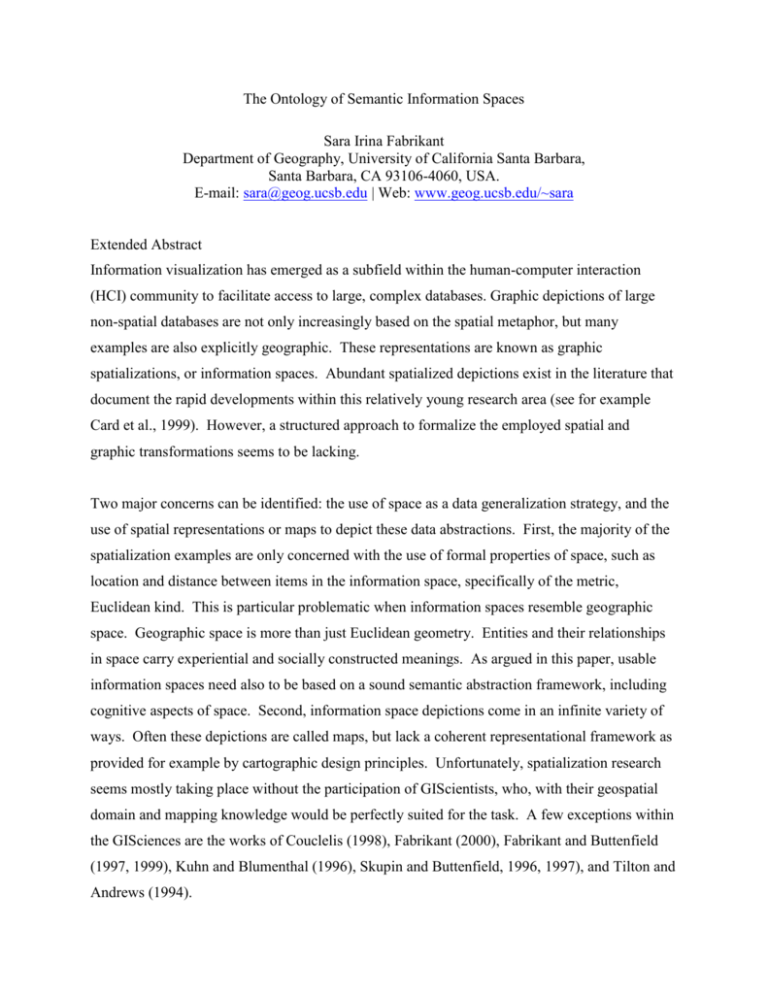The Ontology of Semantic Information Spaces
advertisement

The Ontology of Semantic Information Spaces Sara Irina Fabrikant Department of Geography, University of California Santa Barbara, Santa Barbara, CA 93106-4060, USA. E-mail: sara@geog.ucsb.edu | Web: www.geog.ucsb.edu/~sara Extended Abstract Information visualization has emerged as a subfield within the human-computer interaction (HCI) community to facilitate access to large, complex databases. Graphic depictions of large non-spatial databases are not only increasingly based on the spatial metaphor, but many examples are also explicitly geographic. These representations are known as graphic spatializations, or information spaces. Abundant spatialized depictions exist in the literature that document the rapid developments within this relatively young research area (see for example Card et al., 1999). However, a structured approach to formalize the employed spatial and graphic transformations seems to be lacking. Two major concerns can be identified: the use of space as a data generalization strategy, and the use of spatial representations or maps to depict these data abstractions. First, the majority of the spatialization examples are only concerned with the use of formal properties of space, such as location and distance between items in the information space, specifically of the metric, Euclidean kind. This is particular problematic when information spaces resemble geographic space. Geographic space is more than just Euclidean geometry. Entities and their relationships in space carry experiential and socially constructed meanings. As argued in this paper, usable information spaces need also to be based on a sound semantic abstraction framework, including cognitive aspects of space. Second, information space depictions come in an infinite variety of ways. Often these depictions are called maps, but lack a coherent representational framework as provided for example by cartographic design principles. Unfortunately, spatialization research seems mostly taking place without the participation of GIScientists, who, with their geospatial domain and mapping knowledge would be perfectly suited for the task. A few exceptions within the GISciences are the works of Couclelis (1998), Fabrikant (2000), Fabrikant and Buttenfield (1997, 1999), Kuhn and Blumenthal (1996), Skupin and Buttenfield, 1996, 1997), and Tilton and Andrews (1994). This paper aims at creating an ontology of semantic information spaces, using empirical evidence on its usability as a starting point. Results of usability evaluations not only allow deriving explicit design guidelines, but also enable to construct of a solid theoretical and representational framework. A theory of semantic information spaces, as argued in this paper, should be based on ontological, semiotic and semantic considerations. An ontological approach helps to conceptualize the entities populating an information space (e.g. documents in an archive). Explicit formal knowledge of entities and their relationships must be determined prior to applying the metaphorical mapping. The semantic strategy deals with identifying sound metaphorical mappings to encapsulate the meaning that needs to be preserved within the information space. Finally, semiotic considerations assure that information spaces are depicted following a sound representational strategy. Two research areas can benefit from this approach. First, semantic information space design is the basis for effective and unambiguous communication between information providers and information seekers. Generalization through semantic abstraction of data archive content will increase in importance if data archives are expected to grow exponentially. A sound theoretical spatialization framework enables information designers to construct conceptually robust and usable information spaces and allows information seekers to more efficiently extract knowledge buried in large digital data archives. On the other hand, a representational framework of space grounded on ontological and semantic principles can be transferred to the explicit geographic domain as a basis to reduce current limitations of how geographic space is represented within GISystems. Work Cited Card, S. K., Mackinlay, J. D., and Shneiderman, B. (1999). Readings in Information Visualization. Using Vision to Think, Morgan Kaufmann, San Francisco, CA. Couclelis, H. (1998). Worlds of Information: The Geographic Metaphor in the Visualization of Complex Information. Cartography and Geographic Information Systems, vol. 25, no. 4: 209-220. Fabrikant, S. I. (2000). Spatialized Browsing in Large Data Archives. Transactions in GIS, vol. 4, no. 1: 65-78. Fabrikant, S. I. and Buttenfield, B. P. (1997). Envisioning User Access to a Large Data Archive. Proceedings, GIS/LIS '97, Cincinnati, OH, Oct. 28-30, 1997: 686-692. page 2 Fabrikant, S. I. and Buttenfield, B. P. (1999). Exploring Semantic Spaces: Geographic Metaphors for Information Access. Submitted to the Annals of the Association of American Geographers. Kuhn, W. and Blumenthal, B. (1996). Spatialization: Spatial Metaphors for User Interfaces, Department of Geoinformation, Technical University of Vienna, Vienna. Skupin, A. and Buttenfield, B. P. (1996). Spatial Metaphors for Visualizing Very Large Data Archives. Proceedings, GIS/LIS '96, Denver, CO, Nov. 19-21, 1996: 607-617. Skupin, A. and Buttenfield, B. P. (1997). Spatial Metaphors for Display of Information Spaces. Proceedings, AUTO-CARTO 13, Seattle, WA, Apr. 7-10, 1997: 116-125. Tilton, D. W. and Andrews, S. K. (1994). Space, Place and Interface. Cartographica, vol. 30, no. 4: 61-72. page 3






